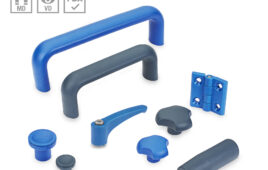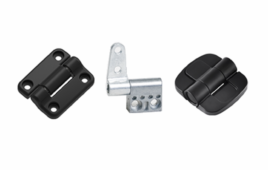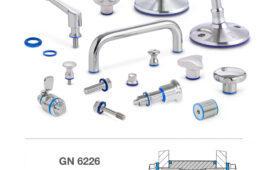
Hinges are used to join two parts together, forming a revolute joint between them.
Hinges are used to join two parts together while allowing them to rotate relative to each other. They typically have two flat faces, known as leaves. One leaf is attached to each of the parts being joined.
The leaves usually have holes in them, so that screws or bolts can be used, and form into a knuckle. This is so a pin can pass through to form the connection between the two rotating parts.
Most hinges provide a perfect revolute joint. This means that only relative rotation about a single axis is allowed between the objects that are joined by the hinge. All translations, as well as rotations about any other axis, are prevented. Therefore, a revolute joint has one degree of freedom (1-DOF).
Some hinges provide a more complex motion. For example, this may be to allow doors and windows to move straight out from a recess before swinging open. Hinges, which provide these more complex motions, require more than one pin, often arranged as a four-bar linkage.
Door and window hinges
Hinges are almost always used to attach doors and windows in buildings, vehicles, cabinets, and enclosures. Several standard types of hinges are available for these purposes:
- Butt or mortise hinge: Designed to be recessed (mortised) into doors and door frames to allow doors to close with only a minimal gap between the door and the frame. These are the most common type of hinge used to hang doors. Three or four hinges are normally used.
- Self-closing or spring hinge: Often used for fire-doors, and sometimes in combination with magnetic door openers that will release the door if a fire is detected.
- Continuous hinges or piano hinges: Long hinges, which may be cut to length, designed to run the entire length of a door or panel.
- Concealed hinges: More complex linkage hinges that allow a door to move straight out from a recess before swinging open. They’re often used for cabinet doors, such as in kitchen units. They may include springs and dampers.
Special-purpose hinges:
- Gate hinges: Gate hinges are able to withstand the considerable forces exerted by a gate, which is cantilevered out from the gate post. They often include an adjustment, which allows the height and angle of the gate to be adjusted.
- Structural frames and trusses: Many systems are available for the construction of frames of trusses from standard components. Examples include scaffolding which uses round tubes and t-slotted aluminum profile systems. These systems often include specially designed hinges to create pin joint connections between structural members.
- Hinge switches: Door hinges that are integrated with safeguard switches. They’re used on doors and hatches in guarding around machinery and other safety applications requiring interlocking.
- Cylinder mounting hinges: Pneumatic and hydraulic cylinders often need to be attached with revolute joints at each end. They may be designed to accept a pin or a separate hinge component may be attached to their end faces.





Tell Us What You Think!